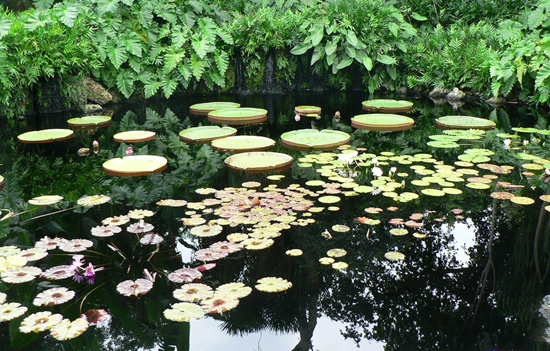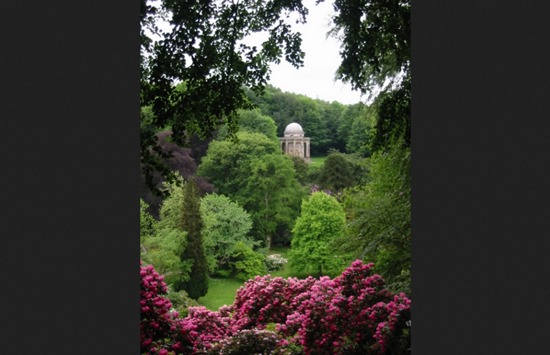
Your backyard can be a wonderful retreat, but whenever you have the chance, you should visit a large, professionally curated public garden. Here are a few you might not be familiar with, but are worth a trip.
1. Fairchild Tropical Botanic Gardens - Coral Gables, Florida, USA
Fairchild Tropical Botanic Gardens is an education and conservation facility showcasing tropical plants. The gardens are home to over a dozen areas highlighting different ecosystems and species, as well as a research facility and a farm; the facility also offers horticultural classes, hosts festivals, and conducts research projects in 20 countries. For the casual visitor, there are guided tours and tram tours, or you can wander freely as you like. Make sure to stop by the Silbey Victoria pool, which features Victoria cruziana and the Victoria Longwood Hybrid water lilies (pictured above). Native to South America and capable of reaching nearly 2 feet in diameter, these plants are the largest water lilies in the world.
2. Château De Villandry - Centre-Val-De-Loire, France
France's Château de Villandry is a manor house with a nearly 500-year history. It was built in the early 16th century by Jean Le Breton, who was Minister of Finance under King François I (he knocked down most of an old fortress on the site, which dated back to the 1100s, in order to build the manor). He began cultivating the gardens, and 200 years later, the Marquis de Castellane expanded them. Château de Villandry was confiscated during the French Revolution and awarded to Napoleon Bonaparte’s brother, after which it fell into ruin. In 1906, Dr. Joachim Carvallo purchased the chateau and worked to restore the gardens to their former glory. In addition to the imposing chateau, visitors can see the kitchen garden, the cross garden, the water garden, the sun garden, the maze, and the cloud room. The gardens are open every day of the year, but if you can't make it all the way to France, you can still take a virtual tour at the website.
3. Butchart Gardens - Vancouver Island, British Columbia, Canada
In 1904, Robert and Jenny Butchart opened a limestone quarry and cement plant on Vancouver Island. He ran the business; she was the company chemist. Over the next few decades, as areas of the quarry played out, Jenny reclaimed it as a garden. She had tons of topsoil hauled in, and dedicated different areas to garden designs from all over the world, including a Japanese and an Italian garden. Today, all that's left of the original factory is a single chimney; it's been replaced almost entirely by budding flowers and singing birds. Butchart Gardens is now owned by Robin-Lee Clarke, the Butcharts’ great-granddaughter. While opening hours vary, the world-famous gardens are open to the public year-round.
4. Powerscourt Gardens - Wicklow, Ireland
Located about an hour from Dublin, the gardens of the Powerscourt Estate are home to the highest waterfall in Ireland (it's nearly 400 feet tall!). The home on the estate was originally a medieval castle, which was remodeled as a house in the 1730s and reroofed after a fire in 1974. The 47-acre estate contains an Italian garden, a Japanese garden, a sculpture garden, two golf courses, the largest pet cemetery in Ireland, and an extensive forest where you’ll find the Pepperpot Tower, which was modeled after the pepperpot used by Lord Powerscourt at mealtime.
5. Dumbarton Oaks - Washington, D.C., USA
Mildred and Robert Woods Bliss established their home and garden on 53 acres in Washington, D.C., in 1920. Twenty years later, they gifted part of their property to Harvard University, which established Dumbarton Oaks Research Library and Collection; 27 acres went to the government to establish a public park. The facility includes the Bliss’s extensive garden - which includes a rose garden and pebble garden - for their Garden and Landscape Studies programs. The museum is closed for renovations for the rest of this year, but the public gardens are open Tuesday through Sunday from March until the end of October.
6. The Master Of The Nets Garden - Suzhou, China
The Garden of Master of the Nets is only 1.5 acres, but the home, pond, and garden are crammed with delicate beauty. Originally named Fisherman’s Retreat, it was once the home of Song Zongyuan, an official of the Qing Dynasty in the 18th century. However, the verdant sanctuary was actually established several hundred years earlier. It's tranquil during the day, but at night, performers stage concerts in the garden and in various rooms of the pavilion from March to November.
7. Callaway Gardens - Pine Mountain, Georgia, USA
Cason and Virginia Callaway started the Georgia-based Callaway Gardens in 1952, and the family added lakes, man-made beaches, two golf courses, a large forest area, and hotels over the years. The garden features the Callaway Brothers Azalea Bowl, a 40-acre garden with more than 3000 azalea bushes that come alive every spring. You’ll also find the Overlook Azalea Garden, the Meadowlark Garden, and the Thornhill Hydrangea Garden.
8. Keukenhof - Lisse, The Netherlands
Keukenhof Gardens is a showcase of Dutch floriculture in the spring. The word keukenhof means “kitchen garden,” because the site is where Countess Jacqueline of Bavaria gathered fruits and vegetables for Teylingen Castle in the 15th century. In 1641, Keukenhof Castle was built on the site. In 1949, a consortium of bulb importers proposed to use Keukenhof to showcase flowers, and the already-legendary garden was redesigned. Over the course of eight weeks every spring, Keukenhof displays the blooms of some 7 million bulbs, including 800 varieties of tulips. The gardens will be open in 2017 from March 23 to May 21.
9. Stourhead - Wiltshire, England
Stourhead is a 2650-acre estate that became a part of Britain’s National Trust in 1946. The estate was established by the Stourton family, who were the Barons of Stourton for 500 years. While the gardens were planted and expanded by several owners, the Arcadian design was the idea of owner Henry Hoare in 1741. He built Greek temples, an artificial lake, a Pantheon, and other classical Greek structures. The gardens are open to the public every day except Christmas.
10. Chanticleer Garden - Wayne, Pennsylvania, USA
Adolph and Christine Rosengarten built a country home in Wayne, Pennsylvania, in 1913, which Christine named Chanticleer. They then bought adjoining properties for their two children when they became adults. Adolph Rosengarten, Jr. inherited both his parents’ and his sisters’ properties upon their deaths, and when he died in 1990, he left the entire estate to the enjoyment of the public, managed by the Chanticleer Foundation. The 35 acres of gardens include a 10-mile trail through various themed areas like the Pond Garden and Ruin Garden. Chanticleer is open to visitors Wednesday through Sunday from April 1 to November 1, but admission is only open until the 120-space parking lot is full, so visitors are urged to carpool.










No comments:
Post a Comment
Please adhere to proper blog etiquette when posting your comments. This blog owner will exercise his absolution discretion in allowing or rejecting any comments that are deemed seditious, defamatory, libelous, racist, vulgar, insulting, and other remarks that exhibit similar characteristics. If you insist on using anonymous comments, please write your name or other IDs at the end of your message.